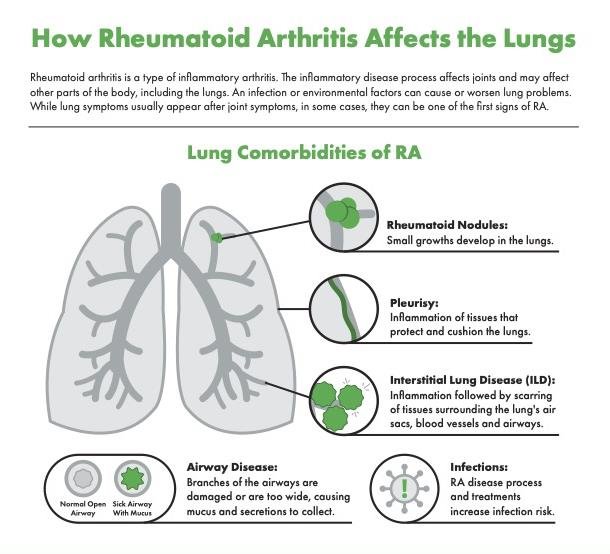What You Need to Know About RA and Lung Disease
Learn more about how respiratory problems are one of the most serious and common complications of rheumatoid arthritis.
By Linda Rath
Besides the joints, the inflammatory process that underlies rheumatoid arthritis (RA) also affects other parts of the body, including the lungs, skin, eyes, digestive system, heart and blood vessels. RA-related lung complications are the most common extra-articular (“outside of the joints”) symptoms of RA and include pulmonary nodules (small growths in the lungs); pleural effusion (a buildup of fluid between the lung and chest wall); bronchiectasis (damage to the airways); and interstitial lung disease (ILD).
In fact, it is estimated that 1 in 10 people with rheumatoid arthritis will develop ILD over the course of their disease, making it as deadly among people with RA as congestive heart failure.
What Is Interstitial Lung Disease?
Interstitial lung disease refers to a group of disorders characterized by inflammation and scarring of the lung tissue. In the case of RA-associated ILD, the scarring is caused when the over-active immune system attacks the lungs. When the scarring builds up over time, breathing becomes difficult, and patients may need lung transplants to regain function.
Click the infographic below to enlarge & download a pdf.
Health concerns can feel overwhelming when the language is full of jargon. This article turns detailed medical information about rheumatoid arthritis and lung disease into plain language you can understand. It gives real context and real steps readers can take next. Your gift supports clarity and confidence for many.
Risk Factors for Interstitial Lung Disease
The risk of developing lung disease is eight times higher in people with RA than in the general population. However, most people with RA are not affected. Risk factors for ILD include:
-
Smoking: People with RA who smoke are more likely to develop ILD.
-
Higher RA disease activity: High levels of rheumatoid factor (RF) and anti-cyclic citrullinated peptides (anti-CCP) antibodies – substances that are indicative of more active disease – increase the risk for development of ILD.
-
Older age at diagnosis: People who are diagnosed with rheumatoid arthritis after age 60 are more likely to develop ILD.
-
Male Gender: Men with RA have a two-to-three times higher risk of developing ILD than women.
-
Treatment with methotrexate and other DMARDs: Several DMARDs, including methotrexate, leflunomide and azathioprine, as well as biologics, particularly tumor necrosis factor (TNF) inhibitors, have been associated with RA-ILD. However, Dr. Teng Moua, a pulmonologist specializing in ILD at the Mayo Clinic in Rochester, Minn., says the risk of methotrexate-induced lung injury is less than 1 percent and is reversible once the drug is stopped. While for many, the benefits of methotrexate far outweigh its risks, it is not recommended for people with existing ILD or RA-ILD by the American College of Rheumatology guidelines.
Diagnosis of Interstitial Lung Disease
It is challenging to catch ILD early because it doesn’t cause any specific symptoms. Once shortness of breath and dry cough develop, the disease has probably already progressed.
The diagnostic process includes a comprehensive clinical exam, X-rays and lung function tests. If there are risk factors for ILD or abnormal X-ray findings, your doctor will likely perform a high resolution CT.
Treatment of Interstitial Lung Disease
Interstitial lung disease is a progressive disease. It is hard to treat and has a high mortality rate. Different factors may affect survival rates including, type of ILD, RA disease duration, time of ILD diagnosis and extent of the disease, older age, male gender, smoking behavior and the presence of lung tissue scarring. Early treatment of ILD reduces mortality risk. Treatment options include:
-
Corticosteroids and immunosuppressants: These treatments may not work the same way for everyone, and patients may experience medication side effects.
-
Oxygen therapy: This may be prescribed along with building aerobic fitness to help improve quality of life.
-
Lung Transplant: In some cases, a lung transplant is an effective and necessary option to regain lung function.
-
Treat underlying RA: The best approach is to treat the underlying RA and resulting inflammation, although ILD may get worse despite well-controlled arthritis.
How Can You Protect Your Lungs?
The best approach to protecting your lungs is to stay vigilant and communicate with your doctor. Here are a few ways to stay on top of RA-related lung complications:
-
Don’t smoke.
-
Get flu and pneumonia vaccines (but always check with your doctor before getting any vaccinations). If you’re taking immunosuppressant medications for your RA, you may be at a higher risk for illnesses like the flu and pneumonia, which may cause further lung-related complications.
-
Visit your doctor for regular check-ups, so your doctor can monitor your lungs.
-
Tell your doctor if you have shortness of breath or dry cough right away.
Trusted, easy-to-understand guidance gives people strength and clarity when it matters most. Your support helps ensure this kind of resource remains available to all. Give today.

Stay in the Know. Live in the Yes.
Get involved with the arthritis community. Tell us a little about yourself and, based on your interests, you’ll receive emails packed with the latest information and resources to live your best life and connect with others.




